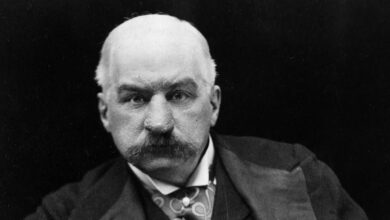“If you have to ask what jazz is, you’ll never know” – Louis Armstrong
Podcast: Play in new window | Download
Subscribe: Spotify | Amazon Music | Youtube Music | RSS
Louis Armstrong Biography
Considered the most important improviser in jazz, Louis Armstrong taught the world to swing. Fondly known as “Satchmo” which was short for “Satchelmouth,” referring to the size of his mouth, or “Pops,” Armstrong was an unassuming jazz master whose sense of humor and positive disposition won the hearts of people everywhere. His profound impact on music continues to grow and thrive into the 21st century.
On 4th August 1901, 16-year-old Mayann Albert gave birth to a little boy who she named Louis following a liaison with the boy’s father, Willie Armstrong. The relationship didn’t last too long and a short time after Louis’ birth, Willie left and Louis was placed in the care of his grandmother, Josephine Armstrong.
Josephine managed to bring in a little money doing laundry for white families, but was only able to keep a small amount of food on the table. As a child, Louis had no toys, very few clothes, and walked around barefoot most of the time. Yet, despite their hardship and struggle, Josephine made sure her grandson attended school and church.
In 1907, when Armstrong was six, he moved back in with his mother who was at that point living in a tough area called Storyville. It was Louis’ job to look after his sister Beatrice, who was born in 1903 and the result of another brief fling between Mayann Albert and Willie Armstrong.
By the time he was seven, Louis Armstrong was looking for work wherever he could find it. He sold newspapers and vegetables and even managed to make a little money singing on street corners with friends. Eventually, he was able to save up enough to buy a used cornet, which he taught himself to play. At the age of 11, Louis quit school to concentrate on supporting his family.
While they were singing on the street, Armstrong and his friends came into contact with many different musicians who played in the Storyville honky-tonks. One of the city’s best-known trumpeters, Bunk Johnson, befriended Louis. He taught the boy songs and techniques and even allowed him to sit in during concerts.
By and large, Armstrong was able to stay out of trouble, although an incident on New Year’s Eve 1912 changed that and the course of his life.
During a New Year’s street party, 11-year old Louis fired a pistol into the air. He was taken into police custody and spent the night in jail. The next morning, the judge sentenced the boy to the Colored Waif’s Home.
The home was run by a former soldier, Captain Jones. Jones’ regime provided discipline, regular meals, and daily classes, all of which had a positive effect on Armstrong.
The home also had a brass band that Armstrong desperately wanted to join. The band director dismissed him out of hand, not wanting a gun-shooting kid from Storyville. So, Louis set about proving the director wrong and worked his way up until he was made the leader of the group.
Then, in 1914, after eighteen months in the home, Armstrong was sent back to his mother.
While he spent his days delivering coal, in his free time Armstrong began to play with pick-up bands in small clubs and at funerals and parades around New Orleans. He began to get noticed by some of the older musicians as well.
It was around this time that Joe “King” Oliver, one of the best trumpet players to be found, became Armstrong’s mentor he was in Kid Ory’s band but when he decided to move to Chicago, Louis replaced him in the band.
On the basis of this position, a year later Armstrong was hired to play riverboats on the Mississippi. Not only did this new opportunity allow Armstrong the chance to play with many prominent musicians, he also learned to read music and how to properly undertake the responsibilities of a professional gig.
In 1922, Joe Oliver invited Armstrong to Chicago to play in his Creole Jazz Band, and so began Armstrong’s lifetime of touring and recording.
After a few years spent playing around the United States with the Fletcher Henderson Orchestra, Sidney Bechet, Ma Rainey, and Bessie Smith, in 1925, Armstrong returned to Chicago and made his first recording as a band leader with his Hot Five.
From 1925 to 1928, Armstrong maintained a rigorous schedule of performing and recording. Highlights from this period include Heebie Jeebies, which introduced scat singing to a wide audience, and West End Blue, one of the most famous recordings of early jazz. Armstrong’s playing steadily improved and his traveling and recording activities introduced his music to an increasing number of people.
Louis Armstrong made his first Broadway appearance in 1929. His recording of Ain’t Misbehavin’ helped set the stage for the popular acceptance of jazz.
By 1932, Armstrong was ready to tour England. He was there for three months and, over the next few years, continued his extensive foreign and domestic tours, including an extended stay in Paris.
When he returned to the States in 1935, Armstrong made Joe Glazer his manager, a position that Glazer would hold for the rest of Armstrong’s career. Under Glazer’s guidance, Armstrong performed in films, on the radio, and in the best theaters, dance halls, and nightclubs in the world.
While his band was performing at the Cotton Club, Armstrong met a dancer called Lucille Wilson, and in 1942 the two were married. The following year, they purchased a home in Corona, Queens where they lived for the rest of their lives.
Throughout the 1950s and 60s, Armstrong continued to appear in films and he made numerous trips abroad, earning him the nickname “Ambassador Satch.”
Armstrong kept touring and playing regularly until recurring health problems began to weigh him down. Still, in the last year of his life, he traveled to London twice, appeared in more than a dozen television shows, and celebrated his 70th birthday at the Newport Jazz Festival.
He was making plans and setting up rehearsals up until a few days before his death on July 6, 1971.
Louis Armstrong’s personality and career continue to have a profound impact on the music scene over half a decade later.
Podcast: Play in new window | Download
Subscribe: Spotify | Amazon Music | Youtube Music | RSS




